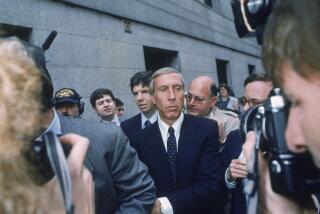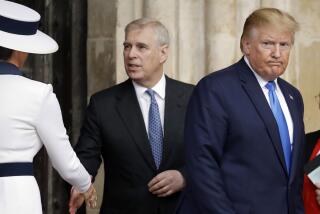Insider Trading, Tough to Prove, Isn’t Part of Stewart Criminal Case
The alleged crime at the heart of the Martha Stewart case is that she sold stock based on information she wasn’t supposed to have -- a classic incident of “insider trading.”
Yet that infraction wasn’t one of the counts against Stewart in the criminal indictment filed Wednesday in New York. Instead, the government charged her with obstruction of justice and lying to investigators who were probing her trading in shares of biotech firm ImClone Systems Inc. in December 2001.
It was left to the Securities and Exchange Commission to bring a civil case Wednesday against Stewart alleging insider trading. But that case, which holds the threat of a financial penalty but not jail time, is likely to be put on hold as the government pursues the more serious criminal indictment, legal experts said.
The omission of an insider-trading count in the criminal case points up one of the long-standing problems the government has faced in securities cases such as this one: It can be tough for prosecutors to definitively show that someone broke the law with a stock trade.
James B. Comey, the U.S. attorney in New York who brought the indictment against Stewart, said he chose not to include a criminal insider trading charge because “in these circumstances [it] would be very nearly unprecedented.”
Instead, Comey focused on what he alleges to be Stewart’s efforts at a cover-up by “repeatedly” lying to the SEC and the FBI about the circumstances involving her sale of nearly 4,000 ImClone shares on Dec. 27, 2001, one day before a government report on ImClone’s key new drug sent its stock plummeting.
Stewart’s attorneys seized on the lack of a criminal charge related to the alleged underlying crime.
“The indictment reveals that the predicate for the entire investigation -- the accusation that Martha Stewart sold her ImClone shares based on inside information -- has proven to be false,” her attorneys, Robert G. Morvillo and John J. Tigue, said in a statement.
“It is most ironic that Ms. Stewart faces criminal charges for obstructing an investigation which establishes her innocence,” they said.
In theory, insider trading might seem a simple accusation to prove, in part because the government has long maintained a very broad definition of the crime. If you buy or sell securities based on “material, non-public information” you have somehow obtained, you are likely to be considered an insider trader.
The Securities and Exchange Commission, and criminal prosecutors, have shied away from defining the crime more specifically because to do so could provide “a blueprint for fraud,” said Jonathan Macey, a securities law professor at Cornell University.
The government has sought to keep for itself the flexibility that comes with the argument that essentially says, “We can’t define it, but we know it when we see it,” according to legal experts.
Over the last two decades, the broad definition of insider trading has allowed the government to bring to justice an array of people who stole -- or “misappropriated,” to use the legal term -- information about pending corporate news that was likely to make the subject company’s stock rise or fall sharply.
Some cases have involved average investors who got a tip from a family member about an important announcement pending from the family member’s company, for example.
The vast majority of insider-trading cases are settled long before any trial. That is because the government has mostly brought “the obvious cases,” said Tom Curran, a former prosecutor who now is an attorney with Edwards & Angell in New York.
Those charged typically are “the ham-handed investors” whose trading in an individual stock stands out from anything they’ve done before, he said. An example, he said, would be a taxi driver who buys a stock after a sleep-deprived investment banker jabbers about a corporate takeover transaction he’s working on.
But proving exactly why a stock trade was made by an active, experienced investor -- say, someone like Stewart, who is a multimillionaire and a former stockbroker -- can be far more difficult, attorneys say.
“With active investors, it’s hard to prove what motivates their buying and selling,” Curran said.
That can be a bigger challenge for criminal prosecutors because they must prove an allegation beyond a reasonable doubt. In a civil case brought by the SEC, prosecutors must only show that a preponderance of the evidence backs up their allegation.
Some legal experts said the root of the case against Stewart -- that she got material, non-public information about ImClone and then acted on it -- isn’t a slam-dunk for prosecutors, and that is probably why Comey omitted the charge.
“I’ve been skeptical all along that whatever information she had was material and non-public,” said Alan Bromberg, securities law professor at Southern Methodist University.
The indictment quotes the text of a policy statement from Merrill Lynch & Co., which is where Stewart’s former broker, Peter Bacanovic, worked, in defining “material” information. The policy says information is material if “a reasonable person would want to consider it in determining whether to engage in a securities transaction, or if it could be reasonably expected to affect the market price of a security if it becomes generally known.”
That is a definition with broad sweep, which serves the government’s purposes, legal experts said. But would it play well with a jury?
Ira Sorkin, a former SEC official now at the law firm of Carter Ledyard & Milburn in New York, said the “short answer” explaining the lack of a criminal insider trading charge may be that prosecutors might be able to show only that Stewart’s broker told her that ImClone’s former chief executive and Stewart’s friend, Sam Waksal, was selling because he expected a downturn in the stock. If so, “That is insufficient in the matter of law to prove she had material, non-public information,” Sorkin asserts.
Still, some attorneys said Comey’s case alleging repeated obstruction of justice by Stewart might be difficult to defend. “I think the government may have a strong case” on that count, Bromberg said.
Stewart’s attorneys, however, made clear that they’re going to fight the criminal case by starting with the premise that she wasn’t charged with insider trading, and therefore that no other charges make sense.
*
(BEGIN TEXT OF INFOBOX)
Charges against Martha Stewart
Stewart faces penalties including up to 30 years in prison and $2 million in fines.
Conspiracy
Counts: One
* Allegedly “willfully and knowingly” worked with her stockbroker Peter Bacanovic to obstruct justice and make false statements to investigators.
Maximum penalty: Five years in prison, $250,000 fine.
Making False Statements
Counts: Two
* Allegedly lied about having a prior arrangement to sell ImClone Systems stock if the price dropped.
* Allegedly lied when she said she didn’t remember being told the Waksal family was selling its ImClone stock.
Maximum penalty: Five years in prison, $250,000 fine for each count.
Obstruction of Justice
Counts: One
* Allegedly tried to hamper SEC investigators by providing misleading information about her sale of ImClone stock.
Maximum penalty: Five years in prison, $250,000 fine.
Securities Fraud
Counts: One
* Allegedly deceived investors in June 2002 by making “misleading public statements” about her ImClone holdings.
Maximum penalty: Ten years in prison, $1-million fine.
Note: Bacanovic also was charged with conspiracy, making false statements, perjury, obstruction of justice and making and using false documents.
Source: Associated Press, court documents
Los Angeles Times
More to Read
Inside the business of entertainment
The Wide Shot brings you news, analysis and insights on everything from streaming wars to production — and what it all means for the future.
You may occasionally receive promotional content from the Los Angeles Times.










